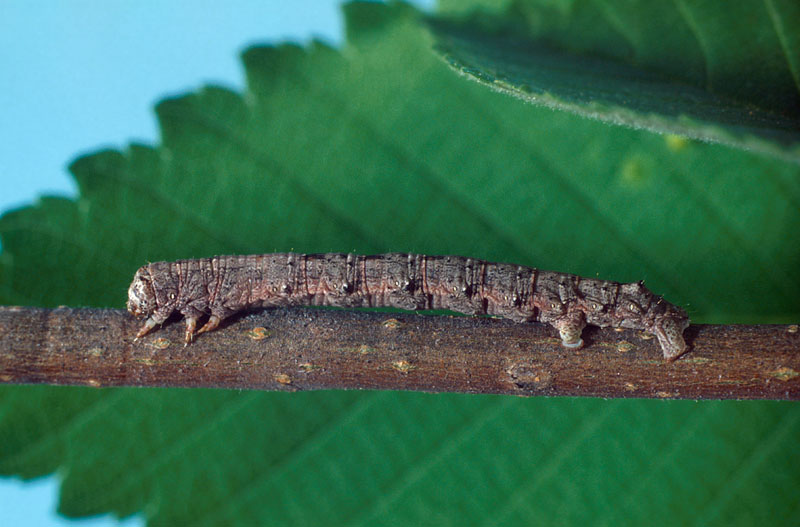Introduction
Paleacrata vernata, also referred to as spring cankerworm, is an insect native to North America that defoliates numerous deciduous trees and shrubs. Larvae appear from late April to early May, chewing small holes in buds and developing leaves. Dense populations are capable of causing extensive defoliation in host plants.
Distribution & Habitat
In the United States, spring cankerworm’s territory extends from New England to North Carolina, and west to North and South Dakota. It may also be found in Arkansas and Texas. In Canada, spring cankerworm ranges from the Maritime provinces to Alberta.
Hosts
Oaks and Siberian elm are the preferred hosts for spring cankerworm. Extensive outbreaks have been reported in forests dominated by oaks or Siberian elm. Spring cankerworm also feeds on the leaves of ash, apple, basswood, birch, black cherry, boxelder, dogwood, elm, hickory, red maple, sugar maple, and white birch.
Life Cycle
Spring cankerworm passes through four stages during its life cycle: an egg stage, a larval stage, a pupal stage, and an adult stage.
The Egg Stage
Eggs are dark gray to brown, with a dark spot on the upper surface. They are barrel-shaped, and measure less than 0.04 inches in diameter. Eggs overwinter and hatch from late April to early May. In warmer regions, eggs may hatch as early as March.
The Larval Stage
Larvae, which are also called inchworms, loopers, or measuringworms, hatch from late April to early May, a period that coincides with the emergence of leaves from the buds on host trees. Larvae are less than 1/16th of an inch when they first appear. They vary in color, ranging from yellow-green to reddish brown. Each larva features a single yellow stripe on either side of their abdomen, as well a longitudinal white stripe that extends along the length of their body. Larvae develop two sets of prolegs, which they use to navigate across trees.
Shortly after emerging, larvae spin silken threads that they cling to. During windy periods, they are disseminated into tree canopies, whereupon they feed on the buds and expanding leaves of host plants. Larvae create small holes in the leaves, consuming all of the leaf tissue except for the major veins and midribs. Larvae mature in four to six weeks. Mature larvae may reach up to an inch in diameter. Once they have fully developed, larvae descend to the ground on a silken thread, immersing themselves in the soil to pupate. They overwinter in the soil, and pupate until early spring.
The Pupal Stage
Larvae envelop themselves in a silken cocoon to pupate. Pupae remain in the soil until late fall or early spring, when they emerge as adults.
The Adult Stage
Adults appear in late winter, during warm spells in February or March. Females are wingless, and grayish brown in color. They may be up to 5/16th of an inch in length. Males have grayish brown wings, and a dull gray abdomen, with two light, wavy stripes on the forewings. Females ascend the trunks of host plants, and navigate onto branches, where they deposit loose clusters of around one hundred eggs in bark crevices, and under bark scales. Adults die shortly after the eggs have been laid.
Effects on Trees
Heavy infestations can cause extensive defoliation in trees. Trees that are defoliated for three or more consecutive years may experience significant branch dieback, and a general decline in vigor. Severe defoliation may contribute to tree mortality. Young, newly transplanted, and weakened trees are susceptible to injury from defoliation.
Management
- Monitoring of spring cankerworm should begin in early May, as the larvae initiate feeding.
- Insecticides can be applied to reduce larvae populations. Bacillus thuringiensis, carbaryl, cyfluthrin, esfenvalerate, malathion, and permethrin are the most effective insecticides available for commercial use. These insecticides are not toxic to beneficial insects, wildlife, or humans. Insecticides must be applied when larvae are less than ½ an inch. Larvae become more resistant to insecticides as they develop.
- Several insects assist in limiting cankerworm populations. Telonomus alsophilae is a tiny wasp that parasitizes the eggs. Calasoma frigidum, a ground beetle, feeds on the larvae.
- On shade trees, a sticky band can be placed around the trunk in late fall to deter females from depositing their eggs. Tree bands are most effective on isolated trees. They are not often deployed in forested settings, where outbreaks are more difficult to manage.
- Late spring frosts can kill newly emerging foliage on host trees, destroying food sources for larvae, and causing populations to collapse.


